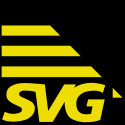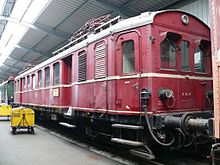Rail transport company
| Rail transport company mbH
|
|
|---|---|
| legal form | GmbH |
| founding | 1996 |
| Seat | Stuttgart , Germany |
| management | Managing Directors: Claus-Jürgen Hauf, Marc Baumgartner |
| Number of employees | 30th |
| Website | www.svgmbh.com |
The rail transport company (SVG) is a private rail transport and infrastructure company (EVU / EIU) with headquarters and operations in Stuttgart and a branch with a museum in Horb am Neckar . The SVG operates exclusively as a special train provider and operates special trains in the field of passenger transport. The SVG is the EVU / EIU of the non-profit association "Friends for the Preservation of Historic Rail Vehicles (FzS)".
Project and business areas
Within the SVG there is an organizational subdivision into five project and business areas: party train, gourmet trips, nostalgic trips, rail service and the Horb am Neckar railway adventure world.
- Party train: Around 90 percent of traffic is now provided by party and football trains. In this segment, SVG has been able to gather a lot of know-how since it was founded in 1996. Every year the SVG handles numerous special trains to major events. The SVG specializes in special music trains with specially equipped disco, party and bar cars, which consist of former rail mail cars of the type bpw-post mr-a. The car park also includes bistro cars with a galley. In the past, large special trains with over 15 cars ran to the Street Parade, Love Parade, Rave On Snow, Wacken Open Air or to numerous Bundesliga games from well-known clubs in the 1st and 2nd Bundesliga and the German Ice Hockey League. For the 2007 DFB Cup final in Berlin between VfB Stuttgart and 1. FC Nürnberg, the SVG deployed three special trains from Stuttgart with 15 cars each and a total of almost 3,000 passengers. 2013 for FC Bayern and VfB Stuttgart a total of 3 trains with around 2,500 passengers.
- Gourmet trips: In a niche market, the SVG also serves gourmets by rail. The museum and operational inventory includes a 1st class and a dining car from the time of the TEE traffic. These two cars are used on special occasions or are lined up in large special trains. The dining car has a complete kitchen equipment. The capacities from the gourmet trip segment are also used in the other business areas, for example in catering for party and football trains as well as in nostalgic traffic.
- Nostalgic traffic: The collection contains several examples of Germany's oldest electric multiple units. All historic electric multiple units , ET 65 and ET 25 , as well as the series 798 rail bus have now been parked (general inspection has expired). With these vehicles, the SVG carried out historical special transports several times between 1998 and 2015 with a total of over 50 operating days per year. In addition, the SVG has a large collection of historical passenger and freight cars of various types, which are exhibited in the Horb am Neckar railway adventure world, including the ET 32 , ET 27 and the ET 30 powered end car . The SVG is the nostalgia partner of the DB Museum and houses some vehicles from the DB Museum .
- Rail-Service: Around 20 years after it was founded, SVG procured its first own line locomotives in spring 2014. From now on, the 1142 654 hauled its own special trains. B. Boxxpress or Rail4Chem are used. In addition, the diesel shunting locomotive 363 689, acquired in February 2012, has been refurbished, which has been performing its own shunting services in the staging area and main station in Stuttgart since July 2014 (previously by DB Regio). From now on, SVG also offers rail services under the name "Rail-Service", including the provision of locomotives, wagons, personnel or the planning, advice and implementation of transports for third parties.
SVG Railway Adventure World Horb am Neckar (EEW)
In December 2008 the SVG announced at a press conference that the SVG would open a railway adventure world on the site of the former Horber freight station. The reason for this is also the Stuttgart 21 traffic project, which means that the operating and storage area in Stuttgart has to be abandoned.
In addition to the museum character of the railway adventure world, the museum is intended to represent the past, present and future as a living mobility center. Modern and classic media are used, which are intended to playfully explain the importance of home and traffic history to children and young people in a variety of ways. Other target groups include day tourists as well as business partners. In addition to exhibition rooms and a cinema, the museum will therefore also have a lecture hall and other rooms that can be used for events, conferences, congresses, vernissages and the like.
Construction of the 250 meter long and up to 40 meter wide storage and exhibition hall began in 2010. The first track construction work began in 2009. At the end of April, civil engineering work began with the construction of a pit to control the rail vehicles. Civil engineering work has been in progress since May 2010. The opening of the museum in the first stage of expansion took place on May 1, 2011. As a partner of the Horb 2011 garden show, a garden tram operated by the SVG ran on the garden show grounds.
In 2012 the garden railway operated on the grounds of the State Garden Show Nagold 2012. The SVG Railway Adventure World is developing into a mobility center. A museum signal box and a garden railway are under construction.
The museum is largely used by large groups of registered visitors and was only open on weekends between April and the end of October in the 2014 season. Since August 1, 2014, the museum has only been open to individual visitors during the season (April to October) on Sundays and public holidays in order to avoid mixing with large groups of visitors on Saturdays. The model railway fairs that take place in spring and autumn, each with around 50 exhibitors, are very popular, for which vehicles from the museum hall are placed in advance for reasons of space.
Since the SVG moved away from the grounds in the Stuttgart Posthof, the railway adventure world has been its only operational center.
Vehicle fleet
SVG's own fleet is divided into the areas of locomotives, passenger cars and freight cars. Over 30% of the existing vehicles are operational. In detail, the following categories are in the vehicle fleet, sometimes in several units:
Traction vehicles
- 1142 654 (Austrian El-Lok) first name: Helene
- 363 689 (diesel shunting locomotive, V 60)
- 323 599 (small diesel locomotive, Köf II)
- 323 851 (small diesel locomotive, Köf II)
Stuttgart vehicles
- ET 85 , - museum
- ET 65 , - Museum (465 005, built in 1933 and 465 006, built in 1933)
- ET 25 , - museum
- ET 27 , - museum
- ET 30 , - museum
- ET 32 , - museum
- 420 300 (opening train of the Stuttgart S-Bahn, built in 1978) - Museum
- 420 400 (prototype S-Bahn Stuttgart ET 420 Plus, renovation 2006) - museum
Other vehicles (selection)
All museum (not operational):
- E 10 (DB El-Lok),
- E 44 (DRG El-Lok),
- VT 11.5 multiple unit (TEE) with three powered end cars and four intermediate cars ,
- VT 98 (rail bus),
- O&K MB 7 N (diesel shunting locomotive),
- 364 533 (diesel shunting locomotive, V 60),
- 240 B (diesel shunting locomotive),
- ME 5212 (diesel shunting locomotive),
- SBB Ae 6/6 (Swiss electric locomotive; loan from SBB Historic),
- NS series 1300 (Dutch electric locomotive)
Passenger cars
- ARmz 211.0 (half dining car ),
- Avmz 111.0 ,
- AByg 503 ,
- B4ye ,
- Byg 514 ,
- Byg 516 ,
- Bcmh 246 ,
- Bcm 243 ,
- BDms 272 ,
- Bdyg 533 ,
- Bm 232 ,
- Bm 234 ,
- Bm 238 ,
- Bn 719 ,
- Bn 720 ,
- Byl 421 ,
- Wgm,
- Wgm 814.
Freight wagons
- It 025 ,
- Fc 089 ,
- Gklm 191 ,
- Uahs ( tank wagons for liquefied gas, hot bitumen and liquid goods),
- Glms 207 ,
- Hbis-ww 297 ,
- Kbs 442 ,
- Ommi 51 ,
- Tims (-ww) 858 ,
- Tms 851 ,
- Uaai 778 ,
- Ucs 909 ,
- Ltd. 51 .
history
The rail transport company was founded in 1996 by Claus-Jürgen Hauf.
Two years earlier, the non-profit association “Friends for the Preservation of Historic Rail Vehicles e. V. (FzS) ”was founded. The aim of the association was and is the operational preservation of historic railway vehicles in Baden-Württemberg. In recent years the association has acquired numerous individual museum pieces or received them on loan for museum preservation.
Rail transport company mbH was founded as an operating company so that the vehicles can run on the routes of the public network. SVG is the operationally active company for operational management, while the non-profit association is responsible for the actual maintenance, preservation and care of over 65 vehicles. The association has over 20 employees who actively take on these tasks on a voluntary basis, as well as taking care of passengers on special trips.
The SVG was one of the first private utility companies to receive a safety certificate. This was renewed in 2012 by the EBA. In addition to the concession for passenger transport, the SVG also has a license for freight transport and is a railway infrastructure operator (EIU).
In the spring of 2014, SVG expanded its business area to include "Rail Service" by purchasing the 1142 El locomotive and the 363 diesel shunting locomotive and offers locomotive services (provision of locomotives with / without staff).
From spring 2020, the company should operate the Flixtrain line Hamburg – Stuttgart.
literature
- Markus O. Robold: Adventure world for railway enthusiasts in Horb. In: Eisenbahn-Kurier , Issue 8, 2012, pages 72-75
- Roland Meier: The historic locomotives and cars of the rail transport company. Rail transport company, Stuttgart 2007, (50 pages, DIN A4)
- Manfred Scheihing: Between ET and freight wagons. In: Eisenbahn-magazin , ISSN 0342-1902 , Issue 8, 2011, pages 25-27
Web links
Individual evidence
- ↑ 2020 timetable with four Flixtrain lines . In: The Railway Engineer . tape 70 , no. December 12 , 2019, ISSN 0013-2810 , p. 53 .

